maintenance Citroen C5 RHD 2015 (RD/TD) / 2.G Owner's Manual
[x] Cancel search | Manufacturer: CITROEN, Model Year: 2015, Model line: C5 RHD, Model: Citroen C5 RHD 2015 (RD/TD) / 2.GPages: 362, PDF Size: 32.4 MB
Page 13 of 362
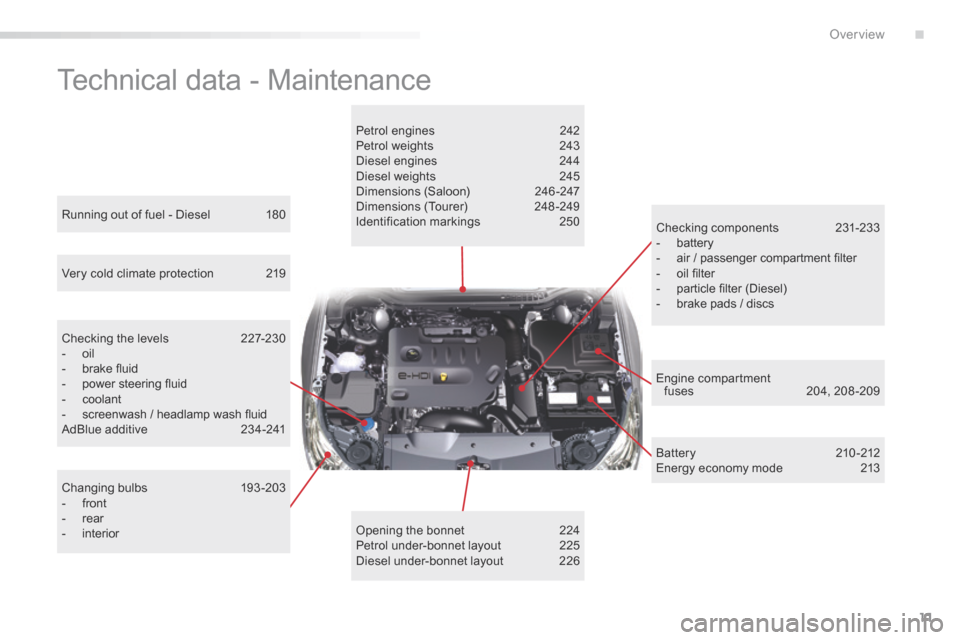
11
Technical data - Maintenance
Petrol engines 242
Petrol weights 243
Diesel engines 244
Diesel weights 245
Dimensions (Saloon) 246-247
Dimensions (Tourer) 248 -249
Identification markings 250
Opening the bonnet 224
Petrol under-bonnet layout 225
Diesel under-bonnet layout 226
Running out of fuel - Diesel
180
Checking the levels 227-230
- oil
- brake fluid
- power steering fluid
- coolant
- screenwash / headlamp wash fluid
AdBlue additive 234-241
Very cold climate protection
219
Changing bulbs 193-203
- front
- rear
- interior Checking components
231-233
- battery
- air / passenger compartment filter
- oil filter
- particle filter (Diesel)
- brake pads / discs
Batter y 210 -212
Energy economy mode 213
Engine compartment
fuses 204, 208 -209
.
over view
Page 15 of 362
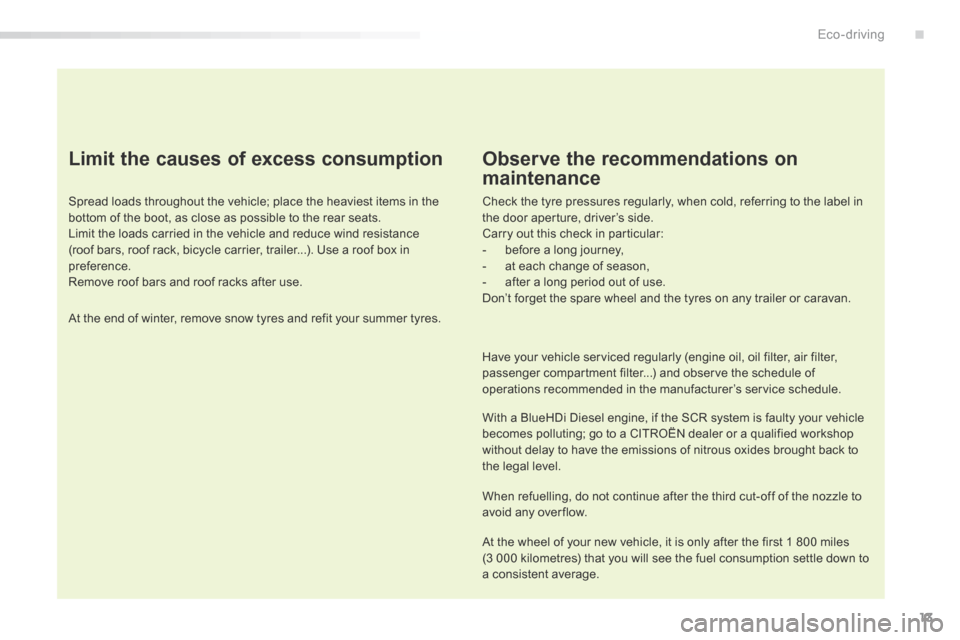
13
Limit the causes of excess consumption
Spread loads throughout the vehicle; place the heaviest items in the
bottom of the boot, as close as possible to the rear seats.
Limit the loads carried in the vehicle and reduce wind resistance
(roof bars, roof rack, bicycle carrier, trailer...). Use a roof box in
preference.
Remove roof bars and roof racks after use.
At the end of winter, remove snow tyres and refit your summer tyres.
Observe the recommendations on
maintenance
Check the tyre pressures regularly, when cold, referring to the label in
the door aperture, driver’s side.
Carry out this check in particular:
- before a long journey,
- at each change of season,
- after a long period out of use.
Don’t forget the spare wheel and the tyres on any trailer or caravan.
Have your vehicle serviced regularly (engine oil, oil filter, air filter,
passenger compartment filter...) and observe the schedule of
operations recommended in the manufacturer’s service schedule.
With a BlueHDi Diesel engine, if the SCR system is faulty your vehicle
becomes polluting; go to a CITROËN dealer or a qualified workshop
without delay to have the emissions of nitrous oxides brought back to
the legal level.
When refuelling, do not continue after the third cut-off of the nozzle to
avoid any over flow.
At the wheel of your new vehicle, it is only after the first 1 800 miles
(3 000 kilometres) that you will see the fuel consumption settle down to
a consistent average.
.
Eco-driving
Page 76 of 362
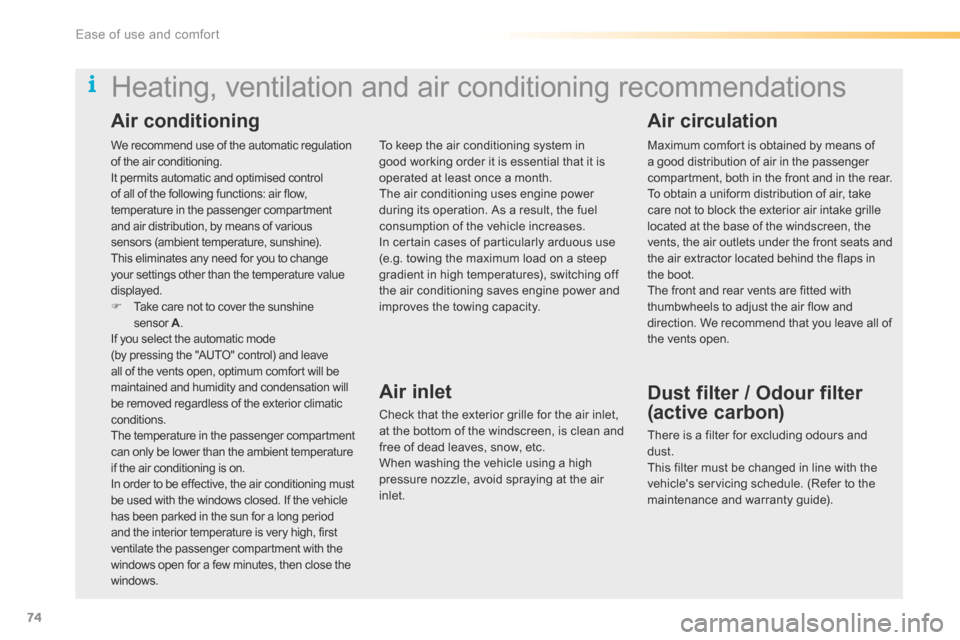
74
We recommend use of the automatic regulation
of the air conditioning.
It permits automatic and optimised control
of all of the following functions: air flow,
temperature in the passenger compartment
and air distribution, by means of various
sensors (ambient temperature, sunshine).
This eliminates any need for you to change
your settings other than the temperature value
displayed.
F Take care not to cover the sunshine
sensor A.
If you select the automatic mode
(by pressing the "AUTO" control) and leave
all of the vents open, optimum comfort will be
maintained and humidity and condensation will
be removed regardless of the exterior climatic
conditions.
The temperature in the passenger compartment
can only be lower than the ambient temperature
if the air conditioning is on.
In order to be effective, the air conditioning must
be used with the windows closed. If the vehicle
has been parked in the sun for a long period
and the interior temperature is very high, first
ventilate the passenger compartment with the
windows open for a few minutes, then close the
windows.
Heating, ventilation and air conditioning recommendations
To keep the air conditioning system in
good working order it is essential that it is
operated at least once a month.
The air conditioning uses engine power
during its operation. As a result, the fuel
consumption of the vehicle increases.
In certain cases of particularly arduous use
(e.g. towing the maximum load on a steep
gradient in high temperatures), switching off
the air conditioning saves engine power and
improves the towing capacity.
Air inlet
Check that the exterior grille for the air inlet,
at the bottom of the windscreen, is clean and
free of dead leaves, snow, etc.
When washing the vehicle using a high
pressure nozzle, avoid spraying at the air
inlet. Maximum comfort is obtained by means of
a good distribution of air in the passenger
compartment, both in the front and in the rear.
To obtain a uniform distribution of air, take
care not to block the exterior air intake grille
located at the base of the windscreen, the
vents, the air outlets under the front seats and
the air extractor located behind the flaps in
the boot.
The front and rear vents are fitted with
thumbwheels to adjust the air flow and
direction. We recommend that you leave all of
the vents open.
Dust filter / Odour filter
(active carbon)
There is a filter for excluding odours and
dust.
This filter must be changed in line with the
vehicle's servicing schedule. (Refer to the
maintenance and warranty guide).
Air conditioning
Air circulation
Ease of use and comfort
Page 120 of 362

118
Tyre under-inflation detection
System which automatically checks the
pressures of the tyres while driving.
The system continuously monitors the
pressures of the four tyres, as soon as the
vehicle is moving.The tyre under-inflation detection
system is an aid to driving which does
not replace the need for vigilance on
the part of the driver. This system does not avoid the need
to check the tyre pressures regularly
(including the spare wheel) and before
a long journey.
Driving with under-inflated tyres
adversely affects road holding,
extends braking distances and causes
premature tyre wear, particularly under
arduous conditions (vehicle loaded,
high speed, long journey).
The tyre pressures for your vehicle can
be found on the tyre pressure label (see
the "Identification markings" section).
The tyre pressures must be checked
when the tyres cold (vehicle stopped
for 1 hour or after driving for less then
6 miles (10 km) at moderate speed).
Other wise, add 0.3 bar to the values
indicated on the label.
Driving with under-inflated tyres
increases fuel consumption.
A pressure sensor is located in the valve of
each tyre (except the spare wheel).
The system triggers an alert if a drop in
pressure is detected in one or more tyres.
Maintenance
Before doing any work under the
bonnet, deactivate the Stop & Start
system to avoid the risk of injury related
to an automatic change to START
mode.
This system requires the use of a 12 V battery
of specific technology and characteristics
(reference numbers available from a CITROËN
dealer or a qualified workshop).
Fitting a battery not listed by CITROËN would
introduces the risk of faults with the system.
The Stop & Start system makes use of
an advanced technology. All work on
this type of battery must only be carried
out by a CITROËN dealer or a qualified
workshop.
driving
Page 195 of 362
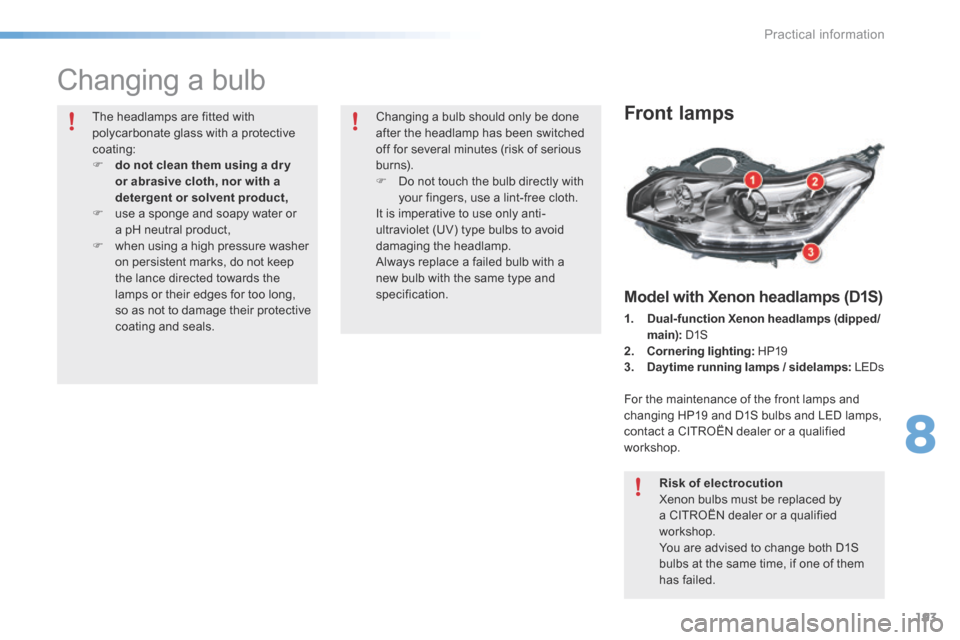
193
Changing a bulb
Front lamps
Model with Xenon headlamps (D1S)
1. Dual-function Xenon headlamps (dipped/
main): D1S
2. Cornering lighting: HP19
3. Daytime running lamps / sidelamps: LEd s
For the maintenance of the front lamps and
changing HP19 and D1S bulbs and LED lamps,
contact a CITROËN dealer or a qualified
workshop.
Risk of electrocution
Xenon bulbs must be replaced by
a CITROËN dealer or a qualified
workshop.
You are advised to change both D1S
bulbs at the same time, if one of them
has failed.
The headlamps are fitted with
polycarbonate glass with a protective
coating:
F
do not clean them using a dr y
or abrasive cloth, nor with a
detergent or solvent product,
F use a sponge and soapy water or
a pH neutral product,
F when using a high pressure washer
on persistent marks, do not keep
the lance directed towards the
lamps or their edges for too long,
so as not to damage their protective
coating and seals. Changing a bulb should only be done
after the headlamp has been switched
off for several minutes (risk of serious
burns).
F
Do not touch the bulb directly with
your fingers, use a lint-free cloth.
It is imperative to use only anti-
ultraviolet (UV) type bulbs to avoid
damaging the headlamp.
Always replace a failed bulb with a
new bulb with the same type and
specification.
8
Practical information
Page 196 of 362

194
Dipped beam headlamps
F Remove the protective cap B .
F Disconnect the connector by pressing it
between the thumb and index finger.
F Free the bulb from its two metal clamps.
F Take out the bulb.
F Replace the bulb, exerting a slight axial
force.
F Refit the connector, until it is all the way in.
F Refit the protective cap B .
Main beam headlamps
F Remove the protective cap A .
F Disengage the retaining spring.
F Remove the bulb and replace it, paying
attention to the direction of fitting.
F Refit the retaining spring.
F Refit the protective cap A .
Model with halogen headlamps
1. Main beams: H1
2. Dipped beams: H7
3. Directional lighting: H7
4. Daytime running lamps / sidelamps: LEd s
For the maintenance of the front lamps and
changing LED lamps, contact a CITROËN
dealer or a qualified workshop.
Practical information
Page 228 of 362
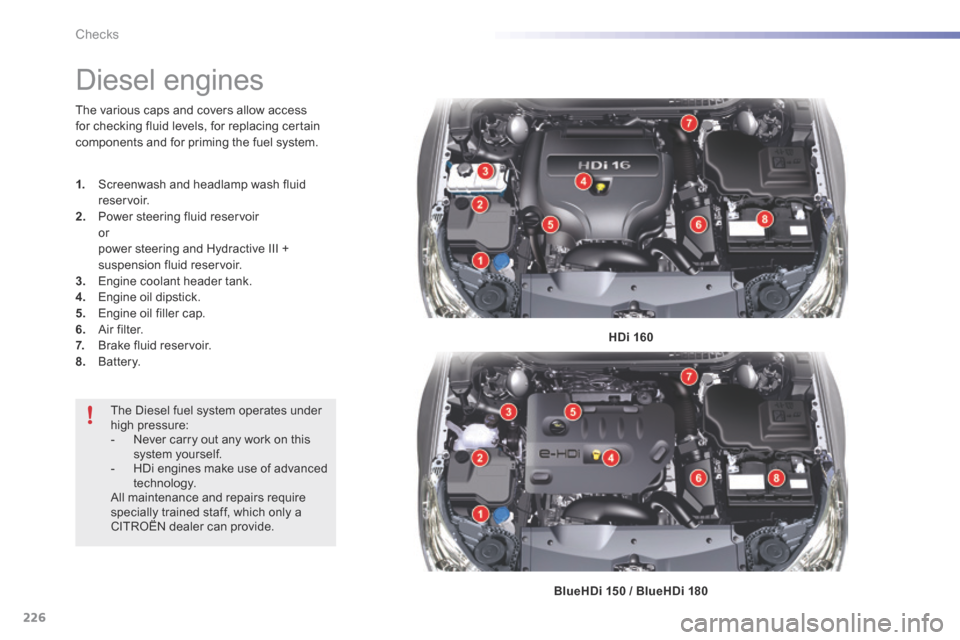
226
Diesel engines
HDi 160
BlueHDi 150 / BlueHDi 180
The various caps and covers allow access
for checking fluid levels, for replacing certain
components and for priming the fuel system.
1.
Screenwash and headlamp wash fluid
reservoir.
2. Power steering fluid reservoir
or
power steering and Hydractive III +
suspension fluid reservoir.
3. Engine coolant header tank.
4. Engine oil dipstick.
5. Engine oil filler cap.
6. Air filter.
7. Brake fluid reservoir.
8. Battery.
The Diesel fuel system operates under
high pressure:
- Never carry out any work on this
system yourself.
- HDi engines make use of advanced
technology.
All maintenance and repairs require
specially trained staff, which only a
CITROËN dealer can provide.
Checks
Page 233 of 362
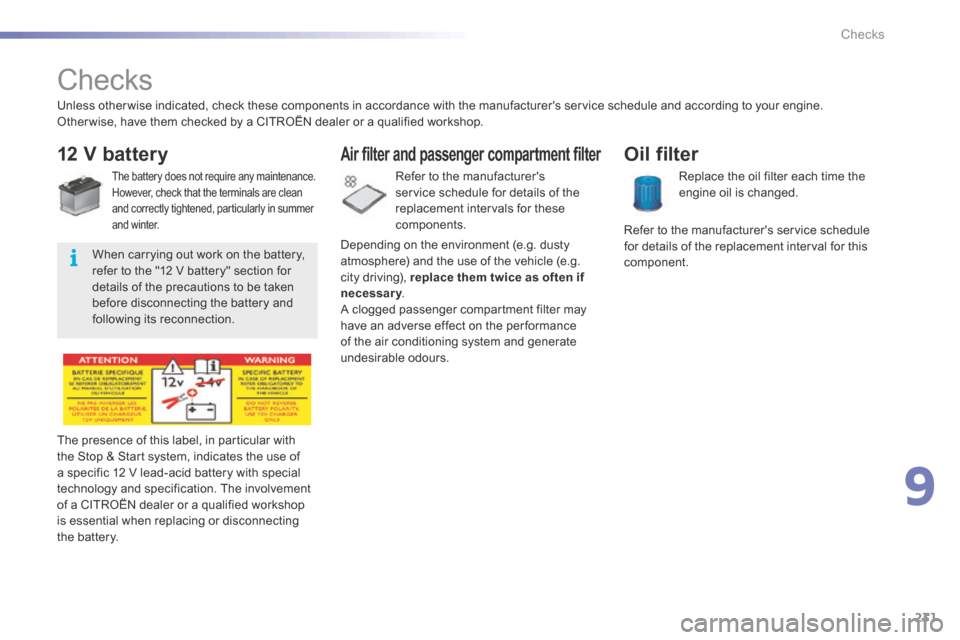
231
Checks
12 V battery
The battery does not require any maintenance.
However, check that the terminals are clean
and correctly tightened, particularly in summer
and winter.
The presence of this label, in particular with
the Stop & Start system, indicates the use of
a specific 12 V lead-acid battery with special
technology and specification. The involvement
of a CITROËN dealer or a qualified workshop
is essential when replacing or disconnecting
the battery. Unless other wise indicated, check these components in accordance with the manufacturer's service schedule and according to your engine.
Other wise, have them checked by a CITROËN dealer or a qualified workshop.
Air filter and passenger compartment filter
Depending on the environment (e.g. dusty
atmosphere) and the use of the vehicle (e.g.
city driving), replace them twice as often if
necessary.
A clogged passenger compartment filter may
have an adverse effect on the per formance
of the air conditioning system and generate
undesirable odours. Replace the oil filter each time the
engine oil is changed.
Oil filter
Refer to the manufacturer's service schedule
for details of the replacement interval for this
component.
Refer to the manufacturer's
service schedule for details of the
replacement intervals for these
components.
When carrying out work on the battery,
refer to the "12 V battery" section for
details of the precautions to be taken
before disconnecting the battery and
following its reconnection.
9
Checks
Page 234 of 362
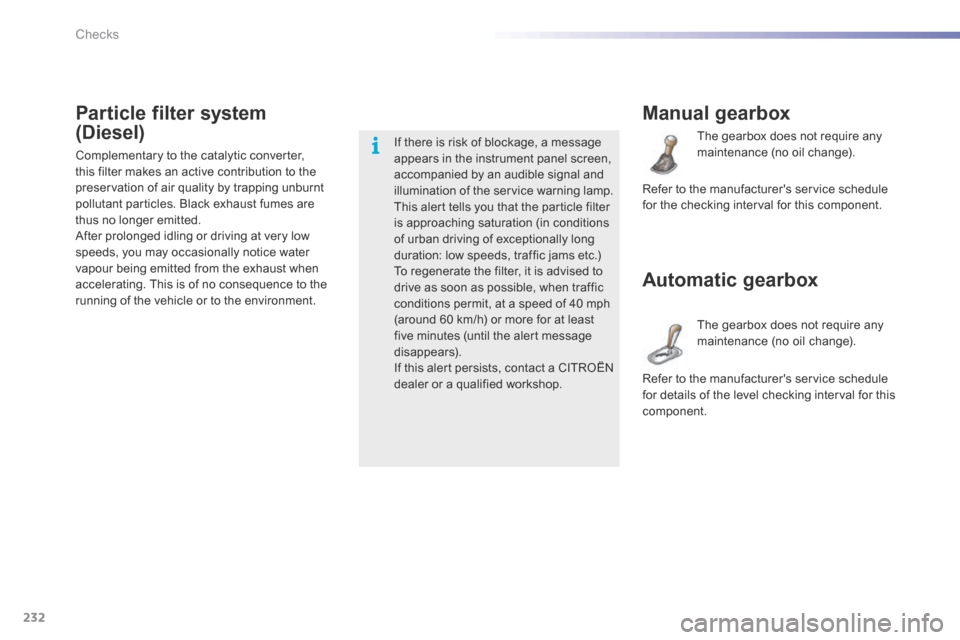
232
Manual gearbox
The gearbox does not require any
maintenance (no oil change).
Automatic gearbox
The gearbox does not require any
maintenance (no oil change).
Refer to the manufacturer's service schedule
for the checking interval for this component.
Refer to the manufacturer's service schedule
for details of the level checking interval for this
component.
Particle filter system
(Diesel)
Complementary to the catalytic converter,
this filter makes an active contribution to the
preservation of air quality by trapping unburnt
pollutant particles. Black exhaust fumes are
thus no longer emitted.
After prolonged idling or driving at very low
speeds, you may occasionally notice water
vapour being emitted from the exhaust when
accelerating. This is of no consequence to the
running of the vehicle or to the environment. If there is risk of blockage, a message
appears in the instrument panel screen,
accompanied by an audible signal and
illumination of the service warning lamp.
This alert tells you that the particle filter
is approaching saturation (in conditions
of urban driving of exceptionally long
duration: low speeds, traffic jams etc.)
To regenerate the filter, it is advised to
drive as soon as possible, when traffic
conditions permit, at a speed of 40 mph
(around 60 km/h) or more for at least
five minutes (until the alert message
disappears).
If this alert persists, contact a CITR
oËn
dealer or a qualified workshop.
Checks
Page 338 of 362
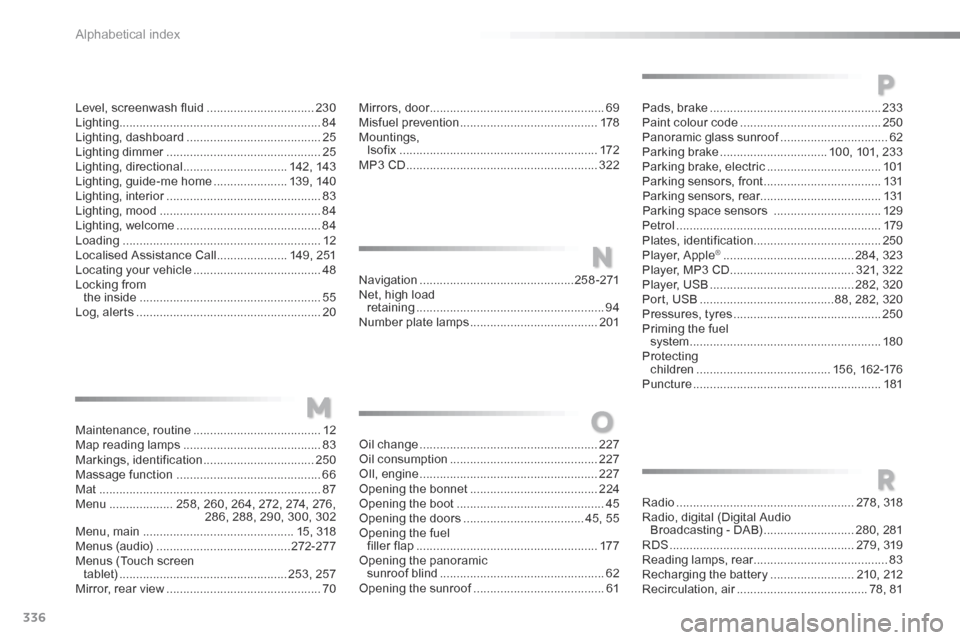
336
Level, screenwash fluid ................................230
Lighting ............................................................ 84
Lighting, dashboard ........................................ 25
Lighting dimmer .............................................. 25
Lighting, directional ............................... 142, 143
Lighting, guide-me home ......................139, 140
Lighting, interior .............................................. 83
Lighting, mood ................................................ 84
Lighting, welcome ........................................... 84
Loading ........................................................... 12
Localised Assistance Call .....................149, 251
Locating your vehicle ...................................... 48
Locking from the inside ...................................................... 55
Log, alerts ....................................................... 20
Oil change ..................................................... 227
Oil consumption ............................................ 227
OIl, engine ..................................................... 227
Opening the bonnet ...................................... 224
Opening the boot ............................................ 45
Opening the doors .................................... 45, 55
Opening the fuel filler flap ...................................................... 17 7
Opening the panoramic sunroof blind ................................................. 62
Opening the sunroof ....................................... 61
O
P
Pads, brake ................................................... 233
Paint colour code .......................................... 250
Panoramic glass sunroof ................................62
Parking brake ................................ 100, 101, 233
Parking brake, electric ..................................101
Parking sensors, front ...................................131
Parking sensors, rear .................................... 131
Parking space sensors ................................129
Petrol ............................................................. 179
Plates, identification ...................................... 250
Player, a pple
® ....................................... 284, 323
Player, MP3 CD ..................................... 321, 322
Player, USB ........................................... 282, 320
Port, USB ........................................ 88, 282, 320
Pressures, tyres ............................................ 250
Priming the fuel system ......................................................... 180
Protecting
children ........................................ 156, 162-176
Puncture ........................................................ 181
Mirrors, door
.................................................... 69
Misfuel prevention ......................................... 178
Mountings,
Isofix ........................................................... 172
MP3 CD ......................................................... 322
M
Maintenance, routine ...................................... 12
Map reading lamps ......................................... 83
Markings, identification ................................. 250
Massage function ........................................... 66
Mat .................................................................. 87
Menu ................... 258, 260, 264, 272, 274, 276,
286, 288, 290, 300, 302
Menu, main ............................................. 15, 318
Menus (audio) ........................................ 272-277
Menus (Touch screen tablet) .................................................. 253, 257
Mirror, rear view .............................................. 70Navigation
.............................................. 25 8 -271
Net, high load retaining ........................................................ 94
Number plate lamps ...................................... 201
N
Radio ..................................................... 278, 318
Radio, digital (Digital Audio Broadcasting - DAB) ...........................280, 281
R dS ....................................................... 279, 319
Reading lamps, rear ........................................ 83
Recharging the battery .........................210, 212
Recirculation, air ....................................... 78, 81
R
alphabetical index